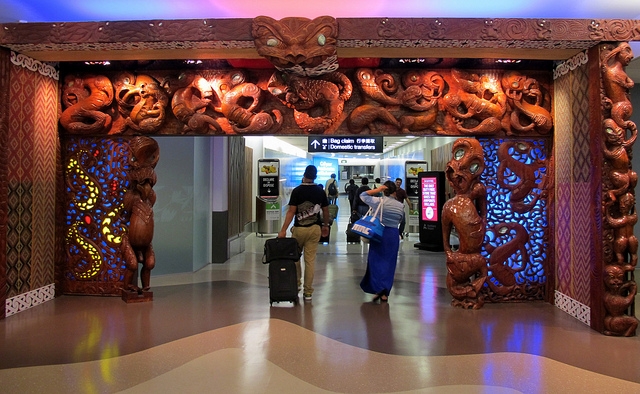
Global travel demand helped deliver Auckland International Airport a solid half-year result but the airport says economic headwinds heading in the local aviation industry’s direction could potentially slow its growth over the second half of the financial year.
Auckland Airport reported a 22% jump in the total number of travellers in the six months to December 2023, bringing it to 9.3 million travellers in total.
Of those travellers, domestic was up 4% to 4.3 million, while international rose 44% to 4.6 million.
The number of international transit travellers increased 33% to 400,000.
Revenue jumped 52% to $440.5 million, while the airport’s underlying net profit soared up 114% to $145.7 million.
Auckland Airport’s board will pay shareholders an interim dividend of 6.75 cents per share.
Actual net profit was at $118.7 million, a massive increase from the $4.8 million that Auckland Airport reported in the comparable period last year, which was affected by an investment property revaluation loss.
Patrick Strange, who chairs Auckland Airport said the half-year hadn’t been without its challenges as some customers had experienced “unacceptable” delays in processing.
But the airport has also seen continued growth in its international network thanks to airlines expanding capacity and new entrants joining the market.
During the six months to December 2023, 27 airlines were flying to 42 international destinations to and from Auckland Airport – which the airport said was only two carriers and one destination short of pre-covid numbers.
Chief Executive Carrie Hurihanganui said the growth in international routes had been “extremely positive” and Auckland was now the most connected city in Australasia to the North American market with seven airlines flying to eight destinations in North America.
The airport also reported high capacity growth from other international markets like India, the Philippines and particularly China markets.
Hurihanganui said there were now five airlines flying to and from six destinations in China and “leisure visitors” had accounted for over 60% of all inbound travellers from China during the airport’s half year, overtaking the number of travellers arriving into the country to visit friends and family.
“India and Philippines markets have also shown strength, with demand for seats exceeding pre-pandemic levels during the period.”
‘Good progress’
Auckland Airport’s infrastructure development programme has made “good progress” and the first stage of its transport hub has almost been completed and is expected to open in April 2024, Hurihanganui said.
“Critical enabling works to prepare for a new domestic terminal connected to the existing international terminal are well advanced,” she said.
In March last year, the airport announced its new domestic terminal was going to cost $2.2 billion while connecting the domestic and international terminals would cost an additional $1.7 billion.
Hurihanganui said on Thursday that major airfield expansion was also underway and the project was on track for completion in late 2025.
It will deliver seven new remote stands for international aircraft and include construction of “3,500m of new stormwater pipes to increase the resiliency of the airport and protect it from extreme weather events”.
Auckland Airport reconfirmed its full-year underlying profit-after-tax guidance to be between $260 million and $280 million.
“As we look to the remainder of the 2024 financial year, we continue to see healthy airline capacity in the market, although headwinds such as the softening of the New Zealand economy may temper the rate of growth,” it said.
Due to the “significant investment” across the airport’s precinct, the airport said it was lifting its capital expenditure guidance to between $1.1 billion and $1.4 billion in its full financial year – up slightly from its previous capex guidance of between $1 billion and $1.4 billion.
4 Comments
Oh, the marvellous joy of being a monopoly. Being able to charge whatever you like and spend as much as you please. Escalating fees does require some degree of pretence in terms of infrastructure investment of course. And with the expanding billion's of responsibility, the senior management could justify large increases in their salaries and remuneration. However that wouldn't be a factor in their decision making; surely?
Oh well good thing Auckland Council has sold down it's stake, couldn't have ratepayers hogging those monopoly profits.
It was perfect timing for the private sector to pick up the shares cheap with earnings still held back by temporary travel reductions still impacted by covid and delays getting planes back into service and now enjoy the predictable return to easy profits..
'Sell the dips' seems to be de rigueur for selling out public ownership of assets.
Is the Domestic Airport in Auckland under AIA's portfolio or is it under different ownership ?
Because the servicing of the planes at the Domestic Airport is not good at all. The security check in, the need to walk to the planes and climb the stairs, the delays on the tarmac in connecting to the air bridge, frequent mechanical issues relating to the airbridges, etc are detracting from the importance of the Domestic Airport terminal as the gateway link to the wider New Zealand. Hope AIA pressures the owners to take care of these.
Contrarian, it's all one in the same. AIAL is in general a fairly incompetent operational entity but does well as a property investor and developer.

We welcome your comments below. If you are not already registered, please register to comment
Remember we welcome robust, respectful and insightful debate. We don't welcome abusive or defamatory comments and will de-register those repeatedly making such comments. Our current comment policy is here.